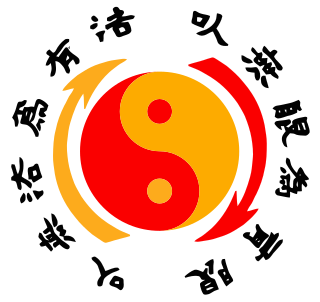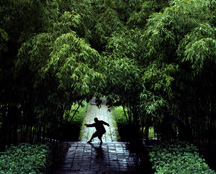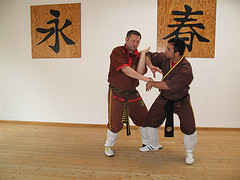Related Research Articles

Wing Chun Kuen, usually called Wing Chun (詠春), as well as Ving Tsun, is a concept-based traditional Southern Chinese Kung fu (wushu) style and a form of self-defense, that requires quick arm movements and strong legs to defeat opponents. Softness and performance of techniques in a relaxed manner is fundamental to Wing Chun.

Jeet Kune Do is a hybrid martial art heavily influenced and adapted by the personal philosophy and experiences of martial artist Bruce Lee.
Siu Nim Tao is the first open-hand form, or taolu, of Wing Chun kung fu. The name is a transcription of the Cantonese pronunciation of the Chinese characters "小念頭". Several other versions of the name are used by different organisations. The second form is called Chum Kiu.

Hung Ga (洪家), Hung Kuen (洪拳), or Hung Ga Kuen (洪家拳) is a southern Chinese martial art belonging to the southern Shaolin styles. The Hallmarks of Hung Ga are strong stances, notably the horse stance or "sei ping ma" (四平馬), and strong hand techniques, notably the bridge hand and the versatile tiger claw. Traditionally, students spent anywhere from several months to three years in stance training, often sitting only in horse stance from half an hour to several hours at a time, before learning any forms. Each form could then take a year or so to learn, with weapons learned last. In current times, this mode of instruction is generally considered impractical for students, who have other concerns beyond practicing kung fu. However, some instructors still follow traditional guidelines and make stance training the majority of their beginner training. Hung Ga is sometimes mis-characterized as solely external—that is, reliant on brute physical force rather than the cultivation of qi—even though the student advances progressively towards an internal focus.

Chinese martial arts, often called by the umbrella terms kung fu, kuoshu or wushu, are several hundred fighting styles that have developed over the centuries in Greater China. These fighting styles are often classified according to common traits, identified as "families" of martial arts. Examples of such traits include Shaolinquan (少林拳) physical exercises involving Five Animals (五形) mimicry or training methods inspired by Old Chinese philosophies, religions and legends. Styles that focus on qi manipulation are called internal, while others that concentrate on improving muscle and cardiovascular fitness are called external. Geographical association, as in northern and southern, is another popular classification method.

Monkey Kung Fu or Hóu Quán is a Chinese martial art which utilizes ape or monkey-like movements as part of its technique.

The movements of the Southern Dragon style of Shaolin Boxing are based on the mythical Chinese dragon. The Dragon style is an imitative-style that was developed based on the imagined characteristics of the mythical Chinese dragon.

A strike is a directed physical attack with either a part of the human body or with an inanimate object intended to cause blunt trauma or penetrating trauma upon an opponent.

Ip Chun, also known as Yip Chun or Yip Jun, is a Chinese martial artist in the style of Wing Chun. He is the elder of two sons. Chun’s father Ip Man was the Wing Chun teacher of Bruce Lee.
The different branches of the Chinese martial art of Wing Chun can be thought of as describing both the differing traditions and interpretations of Wing Chun, and the teacher-student relationships which perpetuate them.

Footwork is a martial arts and combat sports term for the general usage of the legs and feet in stand-up fighting. Footwork involves keeping balance, closing or furthering the distance, controlling spatial positioning, and/or creating additional momentum for strikes.

Kung Fu San Soo (功夫散手) is a Chinese-American martial art. It is based on techniques from all over China, both Northern and Southern Chinese martial arts systems.

Jow Ga Kung Fu is a form of Kung Fu. It was founded by Jow Lung who was born in 1891, on the eleventh day of the third lunar month in Sa Fu Village of the Canton Province, and died in 1919. His father was Jow Fong Hoy and his mother’s maiden name was Li. At the time of its inception, this particular style of Kung Fu was labeled as having the head of Hung Gar, the tail of Choy Gar and the patterns of the tiger and leopard, or simply Hung Tao Choy Mei. It was so labeled because the essential techniques incorporated the muscular and mighty movements of Hung Gar and the swift footwork and complex kicking of Choy Gar, making it a very effective form of self defense with emphasis on simultaneous attack and defense.

Tung Kong Chow Gar Tong Long or simply Chow Gar (周家) is a southern Chinese martial art of the Hakka (客家) people. It is one of the four major schools in Southern Praying Mantis, the other schools being Chu Gar, Kwong Sai Jook Lum, and Tit Ngau. It is an aggressive style with emphasis on close-range fighting. These skills are developed by utilizing a range of training techniques which have been developed over several centuries.

Choy Gar, also Caijia Quan, is a Chinese martial art deriving its name from the Cantonese-born founder, Choy Gau Lee (蔡九儀), and is one of the five main family styles of Kung Fu in Southern China. It was taught to him by a monk named Yi Guan. This style, founded in the 17th century, is a combination of rat and snake styles emphasizing on swift footwork and rapid strikes.

The Legend of the Condor Heroes is a Hong Kong television series adapted from Louis Cha's novel of the same title. The series was first broadcast on TVB Jade in 1994.

Choy Li Fut is a Chinese martial art and wushu style, founded in 1836 by Chan Heung (陳享). Choy Li Fut was named to honor the Buddhist monk Choy Fook who taught him Choy Gar, and Li Yau-San (李友山) who taught him Li Gar, plus his uncle Chan Yuen-Wu (陳遠護), who taught him Hung Kuen, and developed to honor the Buddha and the Shaolin roots of the system.

Victor Kan is a student of the late Ip Man and began his Wing Chun instruction at the age of 13 years in Hong Kong. He was with Yip Man for 7 years and in that time during which he became known as the 'King of Chi Sao' or 'The Untouchable'. By the late 1950s he assisted Yip Man until he left for Europe in 1961. He teaches in the UK and has been doing so since 1975. He also has branches in Italy, Australia and Hong Kong.

Weng Chun Kung Fu also known as Chi Sim Weng Chun is a Chinese Martial Art. Weng Chun in its present form is being preserved by many, including Andreas Hoffman, the successor of the art following late Grand Master Wai Yan.

Lo Man-kam is a Hong Kong teacher of the martial art of Wing Chun.
References
- ↑ "Hong Long Wing Chun Kung Fu". Honglongwingchunkungfu. Archived from the original on 2007-09-30. Retrieved 2007-06-04.
- 1 2 3 4 "Chum Kil: Some introductory points" (PDF). Archived from the original (PDF) on 2007-09-27. Retrieved 2007-06-04.
- 1 2 Wing Chun Kuen Archived 2007-09-29 at the Wayback Machine
- 1 2 Welcome/ Intro Archived 2007-09-28 at the Wayback Machine